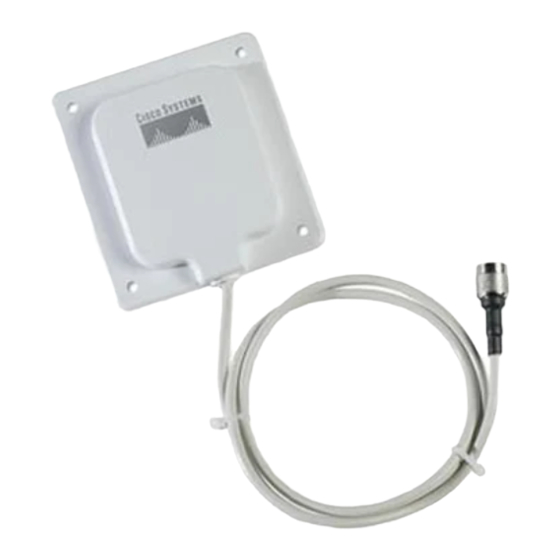
Table of Contents
Advertisement
Quick Links
Cisco Aironet 6-dBi Patch Antenna
(AIR-ANT2460P-R)
This document outlines the specifications, describes the AIR-ANT2460P 6-dBi patch antenna, and
provides instructions for mounting it. The antenna operates in the 2.4-GHz frequency range and is
designed for use in both indoor and outdoor environments.
The following information is provided in this document.
Technical Specifications, page 2
•
System Requirements, page 3
•
Installation Guidelines, page 4
•
Installing the Antenna, page 5
•
Documentation Feedback, page 8
•
•
Cisco Product Security Overview, page 8
Obtaining Technical Assistance, page 10
•
•
Corporate Headquarters:
Cisco Systems, Inc., 170 West Tasman Drive, San Jose, CA 95134-1706 USA
© 2006 Cisco Systems, Inc. All rights reserved.
Advertisement
Table of Contents

Summary of Contents for Cisco Aironet AIR-ANT2460P-R
-
Page 1: Table Of Contents
(AIR-ANT2460P-R) This document outlines the specifications, describes the AIR-ANT2460P 6-dBi patch antenna, and provides instructions for mounting it. The antenna operates in the 2.4-GHz frequency range and is designed for use in both indoor and outdoor environments. The following information is provided in this document. -
Page 2: Technical Specifications
Connector type RP-TNC Length 4 in. (10.1 cm) Width 3.6 in. (9.1) cm) Height 1 in. (2.5 cm) Operating temperature range –22°F to 158°F (–30°C to 70°C) Storage temperature range –40°F to 185°F (–40°C – 85°C) UL2043 compliant Environment Indoor/outdoor... -
Page 3: System Requirements
System Requirements System Requirements This antenna is designed for use with Cisco Aironet access points and bridges but can be used with any 2.4-GHz Cisco Aironet radio device that utilizes an RP-TNC connector. Safety Precautions Translated versions of the following safety warnings are provided in the Safety Warnings for Cisco Aironet Antennas, which is available at http://cisco.com. -
Page 4: Installation Guidelines
Each person should be assigned to a specific task, and should know what to do and when to do it. One person should be in charge of the operation to issue instructions and watch for signs of trouble. -
Page 5: Installing The Antenna
Generally, the higher an antenna is above the ground, the better it performs. Good practice is to install your antenna about 5 to 10 ft (1.5 to 3 m) above the roof line and away from all power lines and obstructions. - Page 6 Use the antenna as a template to mark the locations of the four mounting holes. Step 2 Use a drill and #29 drill bit to drill four holes at the locations you marked in Step 2. Step 3 Start a plastic anchor into each hole.
-
Page 7: Grounding The Antenna
Mount the antenna discharge unit as close as possible to where the antenna cable enters the building. Step 3 Drill a hole in the building’s wall as close as possible to the access point to which you will connect the Step 4 antenna cable. -
Page 8: Documentation Feedback
URL: http://www.cisco.com/go/psirt To see security advisories, security notices, and security responses as they are updated in real time, you can subscribe to the Product Security Incident Response Team Really Simple Syndication (PSIRT RSS) feed. Information about how to subscribe to the PSIRT RSS feed is found at this URL: http://www.cisco.com/en/US/products/products_psirt_rss_feed.html... - Page 9 The link on this page has the current PGP key ID in use. If you do not have or use PGP, contact PSIRT to find other means of encrypting the data before sending any sensitive material. Product Alerts and Field Notices Modifications to or updates about Cisco products are announced in Cisco Product Alerts and Cisco Field Notices.
-
Page 10: Obtaining Technical Assistance
Access to all tools on the Cisco Technical Support & Documentation website requires a Cisco.com user ID and password. If you have a valid service contract but do not have a user ID or password, you can register at this URL: http://tools.cisco.com/RPF/register/register.do... -
Page 11: Obtaining Additional Publications And Information
Submitting a Service Request Using the online TAC Service Request Tool is the fastest way to open S3 and S4 service requests. (S3 and S4 service requests are those in which your network is minimally impaired or for which you require product information.) After you describe your situation, the TAC Service Request Tool provides... - Page 12 Inc. and/or its affiliates in the United States and certain other countries. All other trademarks mentioned in this document or Website are the property of their respective owners. The use of the word partner does not imply a partnership relationship between Cisco and any other company. (0601R)















